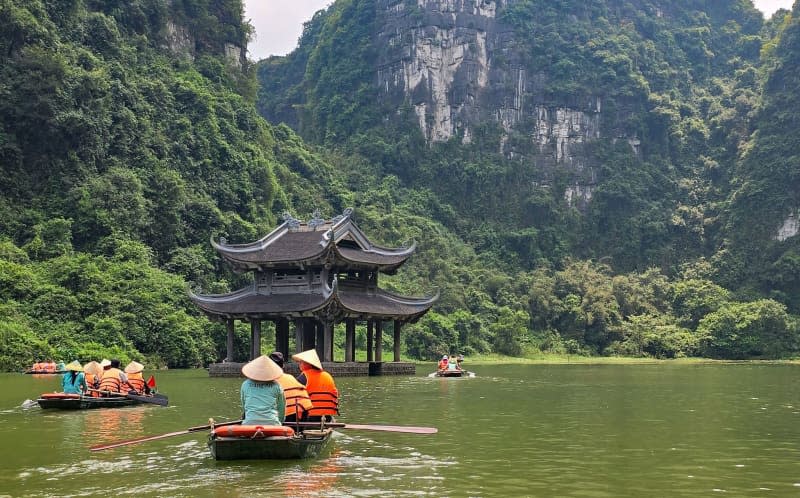Step into a shaky rowboat to explore the dramatic limestone features of Vietnam’s “dry” Halong Bay.
Guides row the boats, traditional sampans, at a leisurely pace through a landscape of towering karst cliffs, lush rainforests and a labyrinthine system of caves.
The bay’s nickname refers to its big sister, the famous Halong Bay, one of Vietnam’s biggest tourist attractions. However, the dry Halong Bay, also known as Tràng An, is not a seascape but is in the centre of the country, some 100 kilometres south of the capital Hanoi.
The region is criss-crossed by the wide delta of the Ngo Dong River, which has shaped this extraordinary landscape over the course of time.
You can easily compare dry Halong Bay with its famous namesake, with the same limestone cliffs and emerald green Gulf of Tonkin. And there are further advantages to its land-locked location.
The Tràng An landscape is less crowded, says our guide, Quy Vu. “And there are no cruise ships here either,” adds Quy, 34, who comes from Ninh Bình and brings guests from Hanoi to his home town several times a week. The bus ride takes around two and a half hours.
As soon as we leave behind the last suburbs of the capital, bustling with honking mopeds, we are in a landscape of rice paddies. Water buffaloes doze in the sun and in villages, people sit in front of their stores and workshops. The pace is leisurely, a lifestyle adapted to the hot and humid temperatures.
Duck your head – we’re entering the caves
But there is hectic movement at the Tràng An jetty, just a few kilometres from the provincial capital of Ninh Bình. Here, in the south of the delta, boat tours set off into the extensive karst landscape of Tràng An, which was declared a World Heritage Site by UNESCO in 2014.
Rows of sampans are bobbing up and down on the water. Boats come and go as they pick up and return guests from their tours. It is a quick turnaround as tours are tightly scheduled to prevent jams of boats forming at the entrances to the caves.
But it is silent, aside from a collective “aah” of the passengers as the boat rounds what appears to be a pagoda built directly in the water. “Keep your head down,” says Quy Vu as the boatman heads for a barely recognisable crevice. Then, the flat-bottomed boat glides silently into the 320-metre Hang Thánh Trượt cave. This is the longest of the nine stalactite caves that the boat traverses during the three-hour tour.
We step out of the boat and head to the Suối Tiên temple during a stopover on land. A few steps lead to the palatial wooden building with a pagoda roof, inside which visitors can kneel and pray in front of ornate golden statues.
A short walk further on, Địa Linh comes into view, a mountain bulging vertically upward out of the water. It is one of the most famous photo motifs in the region.
That this landscape is ideal for the big screen was swiftly seen by Hollywood director Jordan Vogt-Roberts who chose Tràng An as the location for his 2017 film “Kong: Skull Island.”
Although you won’t meet the famous giant ape King Kong, you can still visit the village with its thatched huts that was built especially for the fantasy film.
Attractions like these, the UNESCO recognition, and the landscape have made the area famous, with images shared countless times on social media. Now, the region is bracing for an increase in visitors.
Quy Vu would also like to open a B&B in the near future, perhaps even with a small restaurant. At the same time, the UN title has raised awareness. “We are focussing on gentle tourism. We don’t want uncontrolled construction or littering,” he says.
Bicycle tour to the ancient royal city
Those exploring Tràng An can switch from boat to bike. Narrow side roads lead through settlements with small farms, past vegetable gardens and rice fields, framed by tropical wooded mountains.
The destination of our tour is the old royal city of Hoa Lư, which was built in 968 AD as a military fortress and experienced its heyday under the Đinh, Lê and Lý dynasties in the 11th century. Two temples were rebuilt in the 17th century on the remains of old foundations.
Today, they are the venue for spiritual and cultural events. Of these, the annual Hoa Lư Festival in April is the largest and, with a tradition of around 1,000 years, the best known.
Whether you’re travelling by boat or by bicycle, you can see wild mountain goats scrambling up the steep rock faces. They are the unofficial heraldic animal of Ninh Bình, but also a culinary speciality. “You haven’t really been here if you haven’t tried goat,” says Nguyễn Văn Quyết, chef of the restaurant Thăng Long, where large groups of guests are dining at long tables, sampling goat dishes.
The restaurant’s small souvenir shop has a thematically appropriate eye-catcher: Homemade rice wine with pickled ginger, apples and goat penis. According to the chef, this guarantees “a strength and potency booster for men.”
Sweaty ascent
Strength and energy are required by all for the subsequent hike to Hang Múa, around 10 kilometres away. The highlight is not the cave, but the viewing platform on the 65-metre mountain above.
It’s a sweat-inducing climb up 500 steep steps leading to the top. With the high humidity, regular drinking breaks are must. But the spectacular 360-degree panoramic view of the seemingly endless karst mountains, the bright green rice fields and the meandering river more than reward your effort.
With the depth of a baroque stage set, the landscape is one of the most beautiful in Vietnam. And, as the view from above makes clear, one thing it certainly isn’t: Dry.

A pagoda in Vietnam’s Halong Bay. Bettina Hagen/dpa-tmn

Taking a boat from Tràng An in Vietnam’s Halong Bay. Bettina Hagen/dpa-tmn

Suối Tiên temple, in northern Vietnam’s Halong Bay. Bettina Hagen/dpa-tmn
#dramatic #scenery #Vietnams #Halong #Bay #boat #bike #foot











Leave a Reply